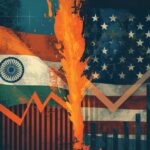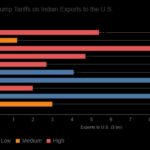India’s Chief Economic Advisor V. Anantha Nageswaran on September 18, 2025, struck an optimistic note on resolving the escalating tariff dispute with Washington, saying he expected the penal duties imposed by the United States to be withdrawn within two months. But industry data and exporters’ accounts suggest the damage may already be deeper and more lasting than policymakers admit.
Speaking at a business gathering in Kolkata, Nageswaran said conversations between New Delhi and Washington were “progressing well” and hinted that the punitive 25 per cent tariff on Indian goods, imposed in late August, could be rolled back by November 30.
“Geopolitical circumstances may have led to the second 25 per cent tariff,” he said, “but considering recent developments, I do believe the penal tariff will not be there after November 30.” He added that reciprocal duties might also be moderated to the 10–15 per cent range that India had earlier anticipated.
The remarks come at a time when exporters are staring at their sharpest contraction in shipments to the U.S. in years. According to the Global Trade Research Initiative (GTRI), India’s exports to the United States fell 16.3 per cent in August to $6.7 billion, their steepest monthly drop of 2025. That marked the third straight decline after tariffs jumped from 10 per cent in April to 25 per cent on August 7 and 50 per cent on August 27.
“September is expected to show an even steeper fall, as it will be the first month fully exposed to the 50 per cent rate,” said Ajay Srivastava, co-founder of GTRI. He warned that if the tariff wall persists through FY26, India could lose $30–35 billion in exports to its single largest market.
Uneven but severe impact
The tariff escalation has not hit all sectors equally. Roughly one-third of Indian exports to the U.S. — worth about $27.6 billion — remain duty-free, including pharmaceuticals, smartphones, and certain metals. Washington also carved out exemptions for iron and steel, aluminum, copper products, and passenger vehicles.
But the pain is concentrated in labor-intensive sectors such as apparel, gems and jewelry, carpets, leather, and shrimp, where the U.S. accounts for 30–60 per cent of global sales. “For small and medium enterprises in these sectors, a 50 per cent tariff is not just a speed bump, it’s a wall,” said a Kolkata-based garment exporter who has seen orders fall by nearly half since July. “Buyers are already shifting sourcing to Vietnam and Bangladesh.”
Shrimp exporters — India’s largest agricultural export to the U.S. — report cancelled shipments and eroding price competitiveness. Gems and jewelry exporters say they are being squeezed by falling demand in the U.S. market even as they battle high input costs at home.
A policy bind
The tariff flare-up underscores the contradictions in India’s external economic strategy. New Delhi has sought to deepen ties with Washington as a counterweight to China, yet continues to import discounted Russian oil, a lifeline for its energy security but a red flag for U.S. sanctions hawks. Washington’s decision to invoke the International Emergency Economic Powers Act — a 1977 Cold War-era statute — to justify tariffs on Indian goods highlights how quickly trade disputes can be entangled with geopolitics.
Domestically, the government has talked up the prospect of $1 trillion in annual exports, but policy support for struggling sectors remains thin. Industry groups have called for faster duty remission, cheaper export credit, and liquidity support to prevent closures. “Without urgent relief, the prolonged tariff wall could lead to job losses and undermine India’s overall trade performance heading into 2026,” GTRI warned.
Nageswaran, however, projected confidence that India’s external sector remains robust, citing $850 billion in current export flows and forecasting a rise to $1 trillion. But exporters argue that headline numbers mask acute sectoral distress. “Aggregate growth tells one story, but the thousands of small exporters in Moradabad, Tirupur, or Surat are facing a very different reality,” said a senior official of the Federation of Indian Export Organizations (FIEO).
Diplomatic signals
Political signals suggest the freeze may not last. U.S. President Donald Trump has in recent weeks softened his tone, expressing hope of finalizing a trade deal with India. He and Prime Minister Narendra Modi spoke by phone on Tuesday, with Trump thanking Modi for “help in ending the war between Russia and Ukraine” — a cryptic statement that analysts say may indicate backchannel diplomacy.
Yet, even if the penal tariffs are lifted after November, exporters worry about longer-term uncertainty. “We can’t keep adjusting to tariff shocks every six months,” said an Ahmedabad-based textile manufacturer. “Buyers need predictability — otherwise they will move supply chains elsewhere permanently.”
Testing the partnership
For New Delhi, the stakes go beyond exports. The U.S. accounts for nearly one-fifth of India’s goods exports and is central to its technology and investment flows. A prolonged tariff standoff would undercut India’s pitch as a stable trading partner at a time when global demand is weak and competition from Southeast Asia is intensifying.
Resolving the dispute may buy temporary relief, but it also exposes the fragility of India’s export-led ambitions. “What we are seeing is the cost of strategic hedging,” said a Delhi-based trade economist. “India wants cheap Russian oil, U.S. markets, and global goodwill — but it cannot have all three without paying a price somewhere.”
For now, exporters are left balancing between hope and uncertainty. The promise of a November rollback may keep factories running, but with September trade figures expected to show an even steeper fall, the question is how much damage will already be locked in before the tariffs are eased — if they are eased at all.






